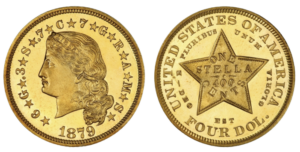The Shocking Scandal Behind the Beloved $4 Gold Stella
Posted onIf you ever saw an episode of the HBO TV drama: The Gilded Age, you understand how exciting this period in U.S. history truly was.
Starting in the 1870’s the U.S. economy was booming. Railroads were built coast to coast. The steel and coal mining industries were growing fast. Titans of industry like John D. Rockefeller, Cornelius Vanderbilt, Henry Ford and Andrew Carnegie built great fortunes.
During this historic time one of the most fascinating and highly desired U.S. rare coins was produced: the $4 gold Stella coin.
Today, these $4 gold coins are extremely rare and in high demand as an example of America’s outstanding numismatic art. And, there’s scandal too which only adds allure to the coin’s dramatic history. Today, that $4 gold coin is reverently known as Stella. How did it get its name? The Latin word for star is Stella and the coin features a five-pointed star on its reverse.
The beautiful Stella was only minted in tiny amounts in 1879 and 1880 as a pattern coin to show Congress, as they debated how it could be used in international trade. The proposed $4 gold coin would roughly equate to the value of the Spanish 20-peseta, the Italian 20-lire and the British sovereign.
However, shortly after the brand new $4 gold pattern coins were released to the Congressman for their review, scandal broke out. These dazzling gold coins were being worn as medallion necklaces dangling over madam’s bosoms in Washington D.C.’s high-end brothels that were known to be frequented by illustrious clientele – like U.S. Congressman!
The numismatic community was dismayed and outraged. While it was said that no coin collector could obtain a Stella from the U.S. Mint, the Congressman who had received the special order apparently used them as gifts and perhaps even payment!
Now remember, this was the Gilded Age and these opulent brothels were famous for large oil paintings, fancy red plush parlor furniture, pricey European carpets, and real silver on the table alongside porcelain dishware. Guests and residents feasted on gourmet meals including high and mid-priced cuts of beef, pork and goat, alongside exotic items for their day – like coconut and Brazil nut. The expensive French champagne was ever-flowing.
And it was in these brothels, that Washington D.C.’s most famous madams proudly flaunted these exceedingly ultra-rare coins! Even today, some Stellas’ can be found that reveal traces of the necklace loops.
In the end, Congress rejected the idea of an international coin. Stella, struck for only two years, was never a circulating coin. Yet, collectors then and for generations have coveted these illustrious and historic coins.
The Stella pattern was only minted in tiny amounts in 1879 and 1880 in two types. Two of America’s most famous coin designers created the Stella patterns.
Chief Engraver Charles Barber created a design that featured a portrait of Liberty facing left with long, flowing hair on the obverse, known today as the Flowing Hair type.
George T. Morgan, the creator of the famous Morgan silver dollars, developed the Coiled Hair type. The reverse of the $4 Stella reveals the motto DEO EST GLORIA, which translates into “God is Glorious.”
These coins are scarce. It is estimated that a mere 425 Flowing Hair coins were minted in 1879, with only 12 known Coiled Hair types from 1879. In 1880, there are only 17 known Flowing Hair types and 8 Coiled Hair. Notably, because the coin goals were international commerce, the obverse states its gold content on the obverse of the coin in the metric system:
“★6★G★.3★S★.7★C★7★G★R★A★M★S★”
This ultra-rarity is beyond the reach of most collectors. Yet, demand for these iconic coins far outstrips supply. On the rare occasions they surface for sale it’s typically from a time-honored, monumental collection of historic U.S. coins. Indeed, the $4 Stella is a historic gem from this exciting time in American history. Imagine the stories these coins could tell, only if they could talk…
Want to read more? Subscribe to the Blanchard Newsletter and get our tales from the vault, our favorite stories from around the world and the latest tangible assets news delivered to your inbox weekly.







